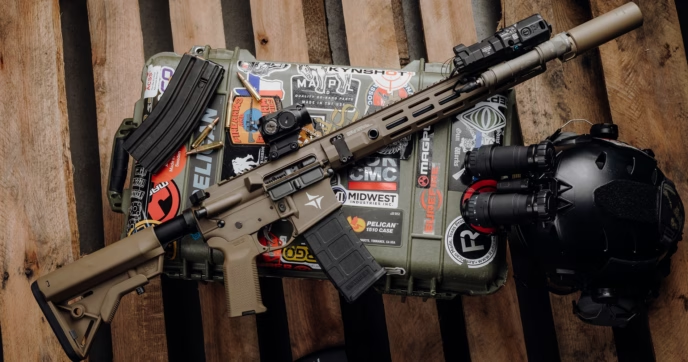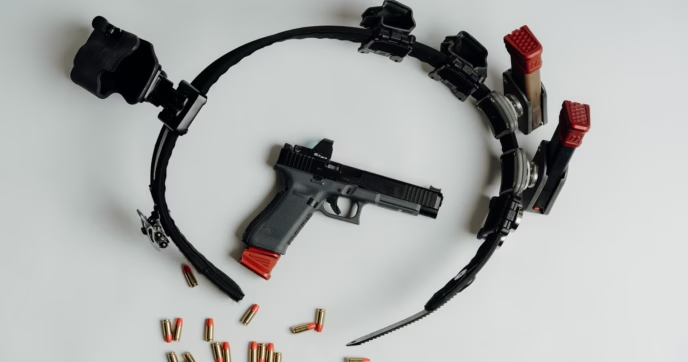It’s undeniable that red dot sights have revolutionized target acquisition, especially in low light conditions. Their ability to provide a clear aiming point without the need for perfect sight alignment and cheek weld makes them invaluable in the fast-paced, reflexive marksmanship involved in duty and public protection. And unlike iron sights, this LED-illuminated optic system has a visible aiming point even in complete darkness—and is much easier to acquire and aim than even tritium-infused night sights.
But what does it take to really run a pistol dot in the dark? In this article from Primary Arms Government, we’re exploring the features of red dots, their low-light benefits, and the different models that you should consider when equipping your pistol with a dot.
What is a Red Dot Sight, and How Do They Work?
A red dot sight is a type of non-magnified optic that uses a simple illuminated reticle—most often a red dot—to provide a precise aiming reference. Unlike traditional iron sights, which require the shooter to align front and rear posts, red dots offer a single focal plane, allowing the shooter to focus entirely on the target. This design drastically reduces the time it takes to acquire a sight picture and make an accurate shot, especially under stress. For duty use, where fractions of a second matter, the simplicity and speed of a red dot can offer a clear tactical advantage.
At the core of a red dot’s operation is a small LED emitter. This emitter projects a red light onto a specially coated lens, which reflects the reticle back toward the shooter’s eye without it being visible from the target’s perspective. The dot appears superimposed on the target, creating a clear point of aim that remains consistent regardless of head or eye position—hence why many are marketed as ‘parallax free’.
Regardless, whether the pistol is drawn from a holster during a nighttime encounter or indexed at an awkward angle around cover, the red dot provides immediate visual feedback. Given the existing challenges of operating in low-light and no-light, the simplicity of a red dot’s aiming system makes it the ideal selection for any duty pistol likely to be used during night hours.
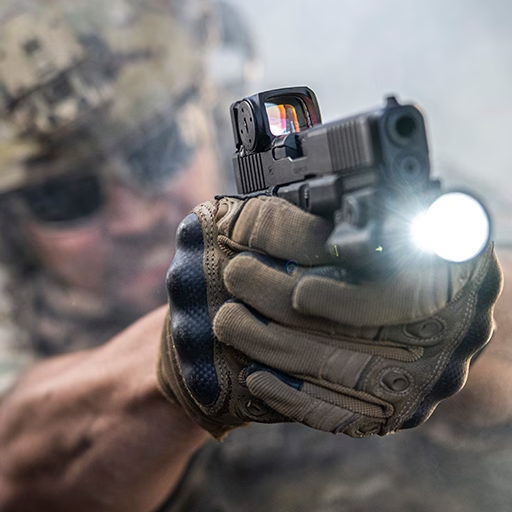
Can You Use Red Dot Sights in Low Light?
Absolutely. In fact, we’d say that red dots are the absolute best optic to choose if you’re going to be dealing with dark environments.
Traditional iron sights can disappear against a dark background, forcing the user to rely on ambient light or weapon-mounted illumination to identify both the target and sight alignment. In contrast, red dots remain crisp and bright, even in near-total darkness. And unlike iron sights which have split focal planes, the single focal plane of the red dot allows you to simply focus on your target, making it easier to correctly evaluate the threat.
Pretty much every pistol red dot designed for duty will have multiple brightness settings, allowing you to fine-tune the reticle’s intensity to match the environment—dim enough to preserve night vision, but visible enough to remain functional under pressure. Some models are also compatible with night vision devices, emitting infrared-only reticles for those operating under NODs.
But whether you’re operating with night vision or with the naked eye, a good quality pistol red dot is always the best choice for a low-light situation.
Types of Red Dot Sights
Red dot optics for handguns have advanced rapidly in recent years, with several distinct formats now available to suit the varying demands of professional carry. While all red dots serve the same essential function—offering a fast, illuminated point of aim—differences in design can affect durability, field of view, environmental exposure, and mounting compatibility with duty-grade pistols.
For handguns used in defensive or service roles, the three most common styles are mini reflex sights, enclosed pistol red dots, and microdots.
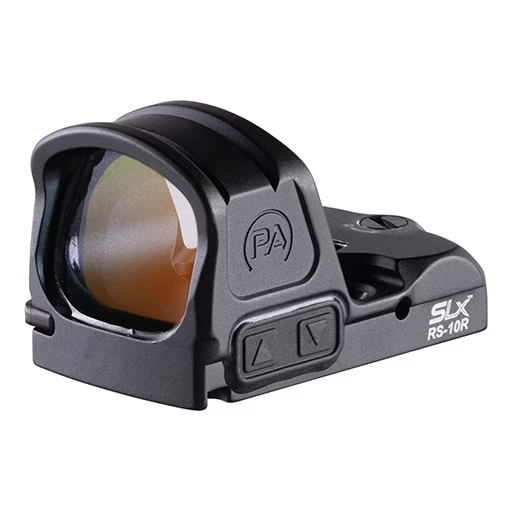
Mini Reflex Sights
Mini reflex sights are a class of open-emitter optics designed specifically for handguns, particularly those used in duty or defensive roles. These sights, such as the Trijicon RMR and Primary Arms SLx® RS-10 feature a single lens and an exposed LED emitter, resulting in a compact and lightweight design. Their minimalistic construction not only reduces the overall weight of the firearm but also maintains a low profile, which is advantageous for holstering and quick draws.
That low-profile design also lends to one of the biggest benefits of a mini reflex sight: their expansive field of view. With only a single lens and relatively thin housing, Mini Reflex Sights tend to have a very clean sight picture with minimal obstruction. This open design allows for rapid target acquisition and situational awareness, crucial in high-stress scenarios where split-second decisions are necessary.
However, the exposed emitter does present some considerations. In environments with heavy dust, rain, or debris, the emitter can become obstructed, potentially compromising the sight picture. Regular maintenance and awareness of environmental conditions are essential to ensure optimal performance.
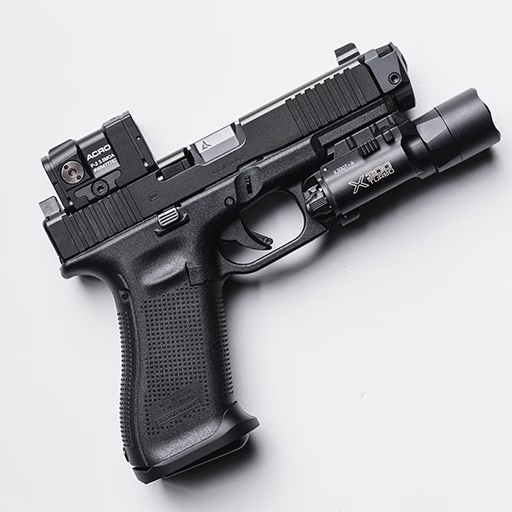
Enclosed Pistol Red Dots
Enclosed pistol red dot sights represent a significant evolution in pistol optic technology, designed to meet the rigorous demands of professional users operating in challenging environments. Unlike open-emitter designs, these optics feature a fully sealed housing that protects the emitter from contaminants such as rain, dust, and debris, ensuring consistent performance regardless of conditions. This sealed design not only enhances durability but also maintains a clear sight picture, a critical factor in high-stress situations where reliability is paramount.
Among the leading options in this category is the Aimpoint ACRO P-2. Renowned for its robust construction, the ACRO P-2 boasts a 7075-T6 aluminum housing and is submersible up to 35 meters, demonstrating its resilience in extreme conditions. Its 3.5 MOA dot provides precise aiming, and the optic offers a remarkable 50,000-hour battery life on setting 6, minimizing maintenance concerns. The side-loading battery compartment allows for quick replacements without removing the sight, preserving zero and ensuring uninterrupted operation.
New to the market, Primary Arms Optics’ PLx® HTX-1 introduces innovative features tailored for professional use. Its patent-pending Modular Chassis System ensures compatibility with a wide range of optics-ready pistols, providing a low-profile mount that co-witnesses with standard-height iron sights. One of the few red dots with ACSS®, the HTX-1 offers a choice between a 4 MOA dot and the ACSS Vulcan® Dot reticle, enhancing target acquisition speed and accuracy. With a side-loading CR2032 battery and AutoLive technology, the HTX-1 delivers extended battery life and immediate readiness.
There aren’t many downsides to an enclosed pistol dot, except that its housing tends to be a little larger visually than a reflex. This isn’t always the case, however, as new optics like the HTX-1 have a fairly large window, making it easy to acquire and track a target.
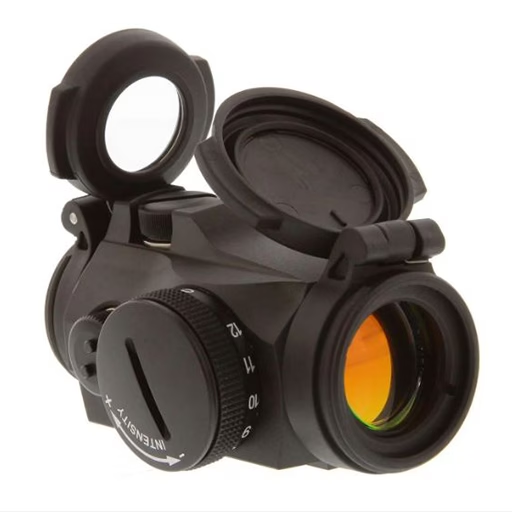
Microdots
One other option for a pistol red dot is a standard microdot—just like those found on carbines. Microdots, like the Aimpoint Micro T-2, are compact, durable red dot sights originally developed for carbines and subguns, but they’ve also found a niche in handgun applications—particularly where pistols are configured with frame-mounted optic systems or chassis platforms. These optics are enclosed, offering excellent protection from the elements, and their rugged construction makes them well-suited for hard use in variable environments. However, the way they integrate with pistols sets them apart from more conventional slide-mounted red dots.
Mounting a microdot to a handgun typically requires a non-standard setup. Since these optics are larger and not designed for direct slide mounting, they are most often installed on pistols with a frame-mounted optic bridge or used within modular chassis systems. This mounting method isolates the optic from slide motion, reducing mechanical stress and extending optic life. That said, this configuration often adds bulk and complexity, making it less suited for standard duty carry.
Accordingly, one of the largest trade-offs with microdots is holster compatibility. Their height and footprint can interfere with common duty or retention holsters, making them a poor fit for concealed or uniformed service applications. That’s why microdots remain more common in competition settings, where speed and sight stability are paramount, and where the shooter has greater freedom in choosing gear without holster restrictions.
Primary Arms Government and First Responder Discounts
Equipping a pistol with a reliable red dot optic is an investment. Many of the best quality optics can be as expensive as the pistol itself, making it a little daunting to get into the pistol optics market. Luckily, for professional customers, Primary Arms Government division offers a range of dedicated purchasing programs tailored to support agencies and individual professionals.
Through the Individual Officer Purchase (IOP) Program, qualified law enforcement officers, military service members, and first responders can access discounted pricing on a wide selection of red dot optics and supporting gear. This includes models from trusted brands like Holosun, Aimpoint, Trijicon, and Primary Arms Optics—making it easier for those in uniform to equip their duty firearms with proven technology. Local Texans also get access to things like the GLOCK Blue Label program as well.
In addition to the IOP program, the Primary Arms Optics Premier Savings Program provides further once-per-year discounts on various optic categories, including pistol optics. If you are seeking the very best price on a Primary Arms Optics product, the Premier Savings Program is undoubtedly the best pick for professional customers.
For larger procurement efforts, Primary Arms Government offers agency-level support with fast quoting, test and evaluation (T&E) opportunities, and even trade-in programs to offset the cost of upgrading to modern optics. This streamlines the purchasing process while ensuring departments can field dependable optics that meet their operational requirements.
To learn more about available programs, visit the Primary Arms Government page or explore the First Responder Discounts for immediate qualification.
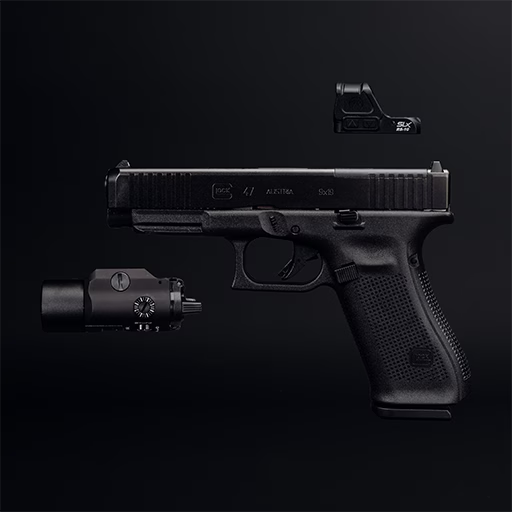
Conclusion
Red dot sights have become an essential upgrade for service pistols, especially in low light environments where traditional sighting systems can fall short. Their ability to provide a consistent, illuminated point of aim enhances both speed and precision, allowing users to stay focused on the threat—not the front sight. For those who rely on their sidearm in unpredictable and often poorly lit conditions, a quality red dot can make all the difference.
Whether it’s the agility of a mini reflex sight, the reliability of an enclosed emitter, or the stability of a frame-mounted microdot, there’s a red dot configuration to match your platform and mission profile. What matters most is pairing the right optic with the right application—and ensuring it’s supported by quality gear and regular training.
And no matter your selection, Primary Arms Government is committed to helping professionals access the tools they need, offering a wide selection of proven optics and personalized support for both individual officers and agencies. With responsive procurement services and exclusive first responder pricing, making the move to red dot optics has never been more attainable.


